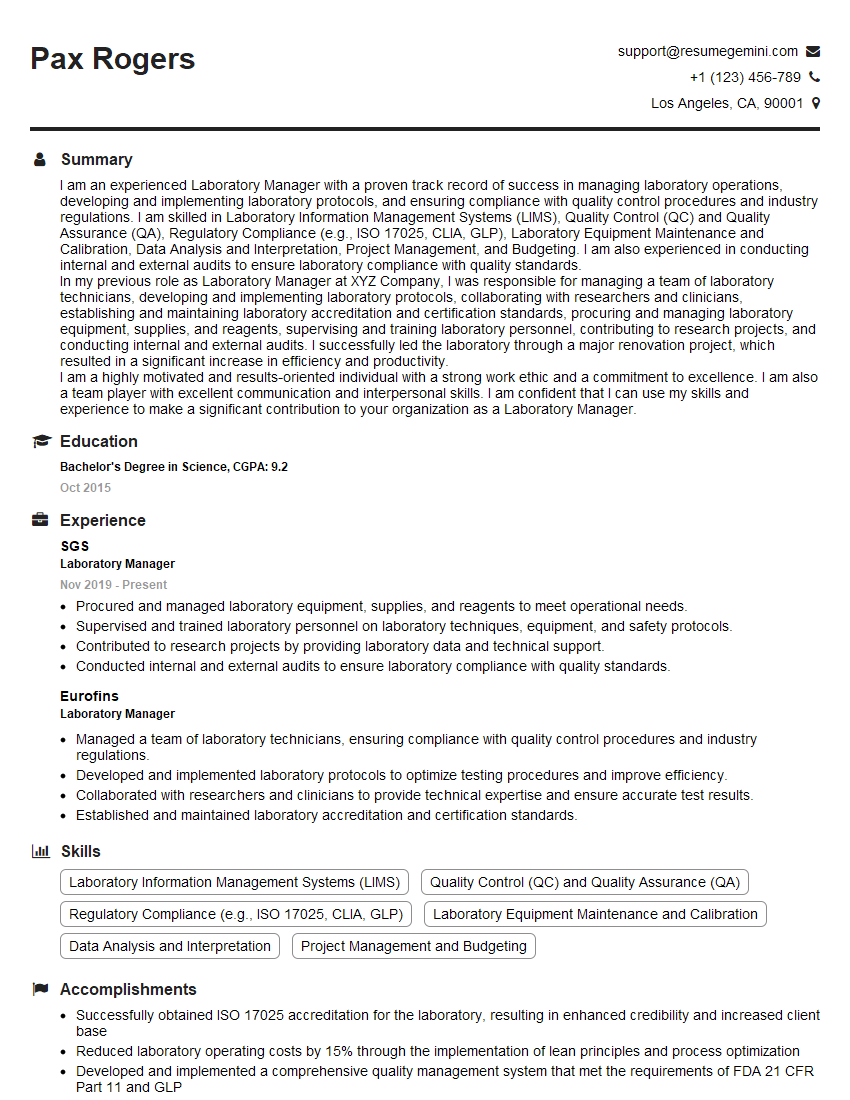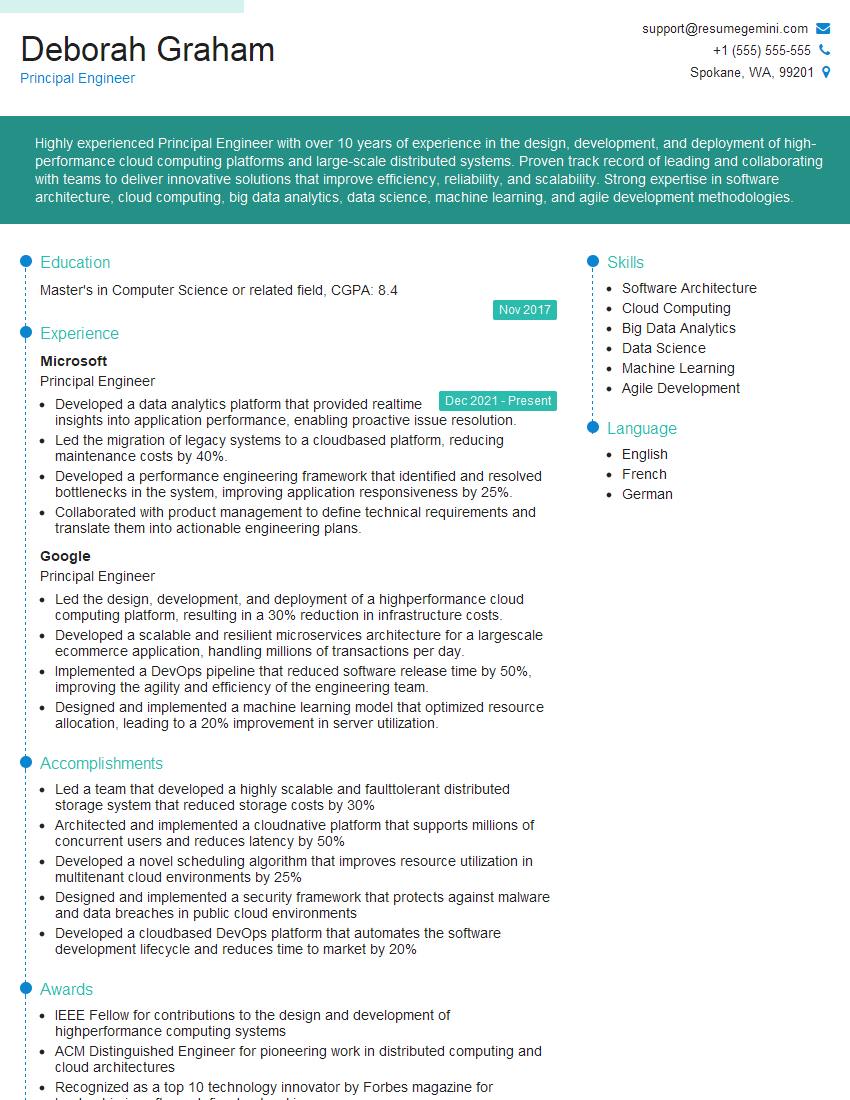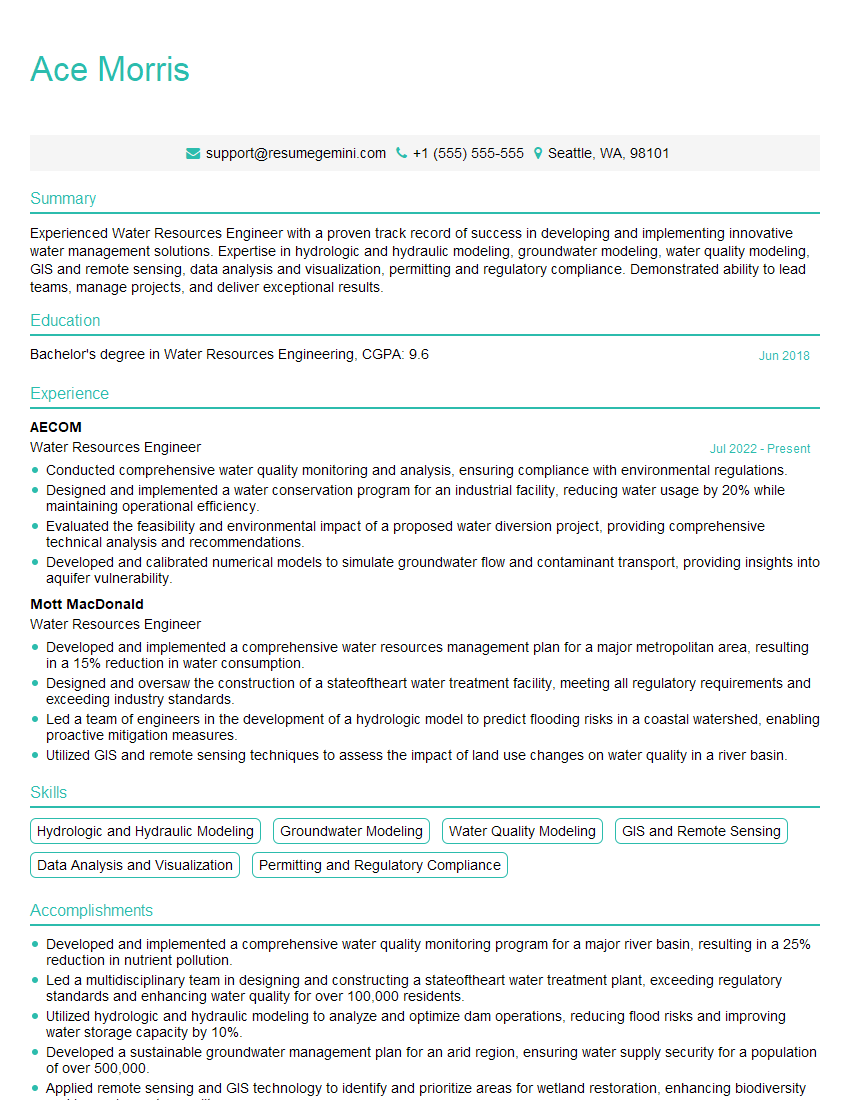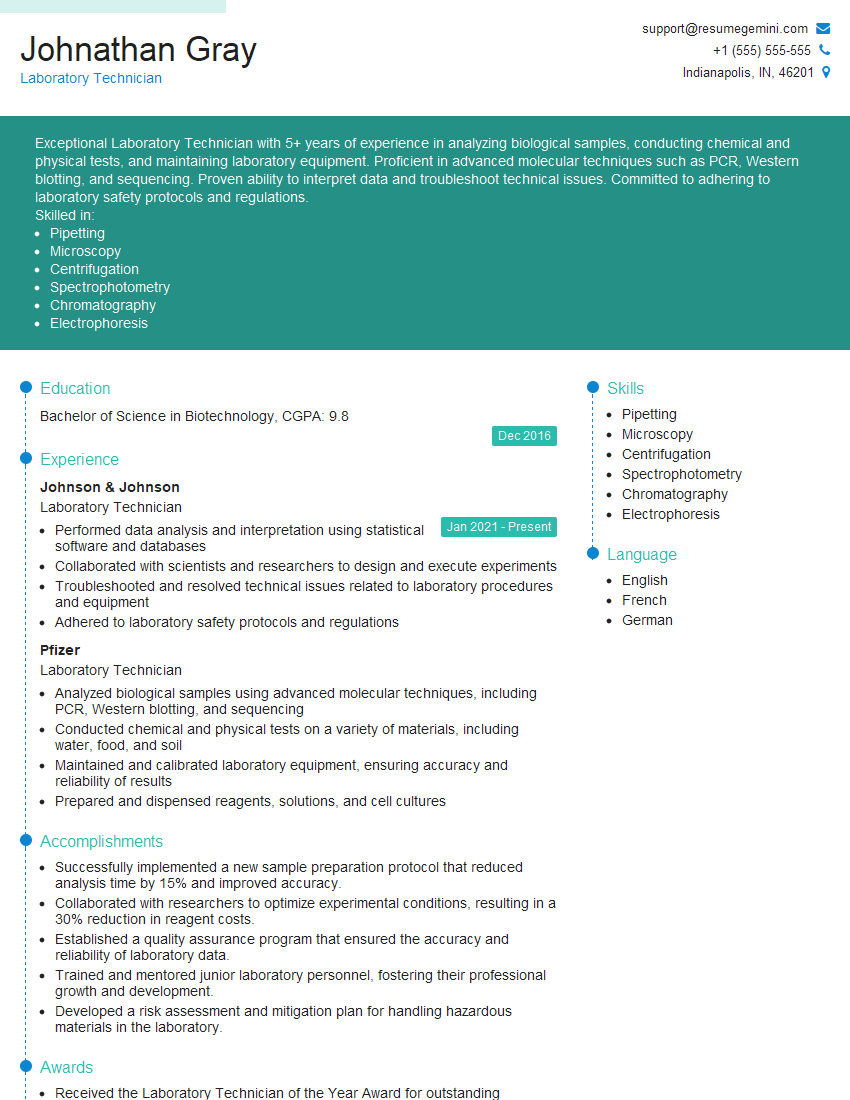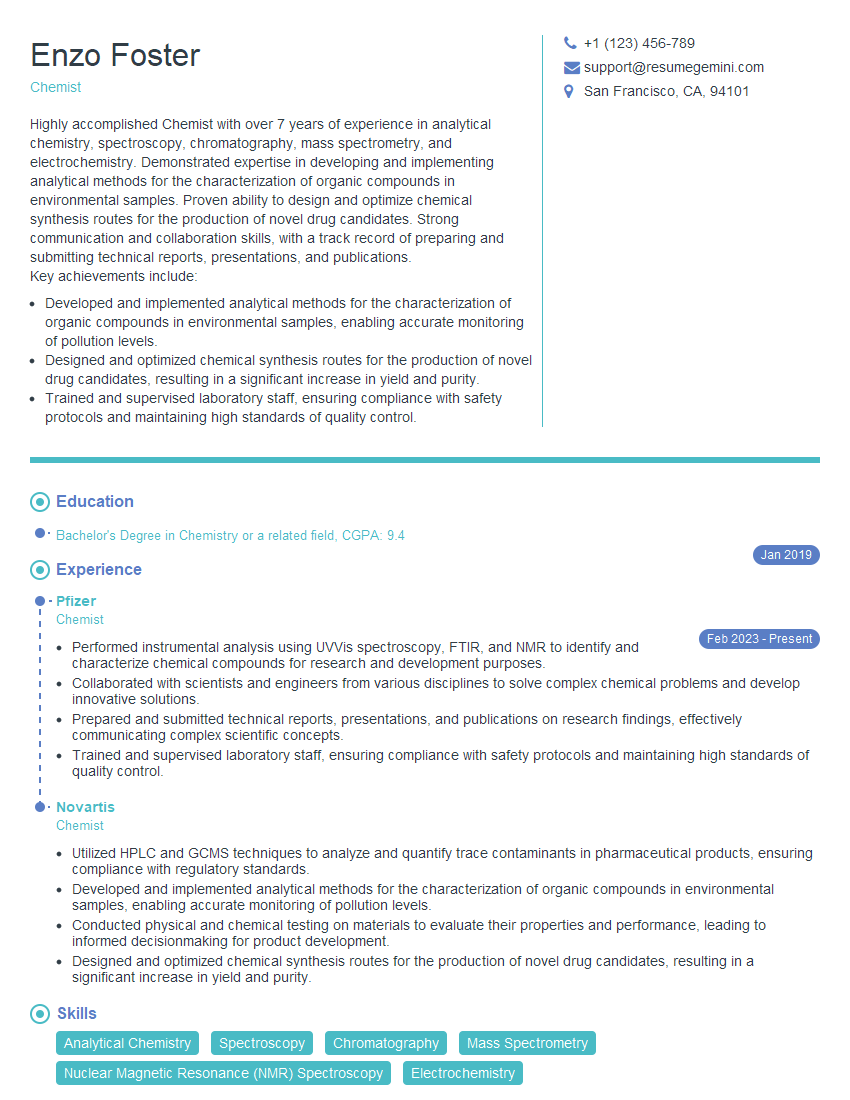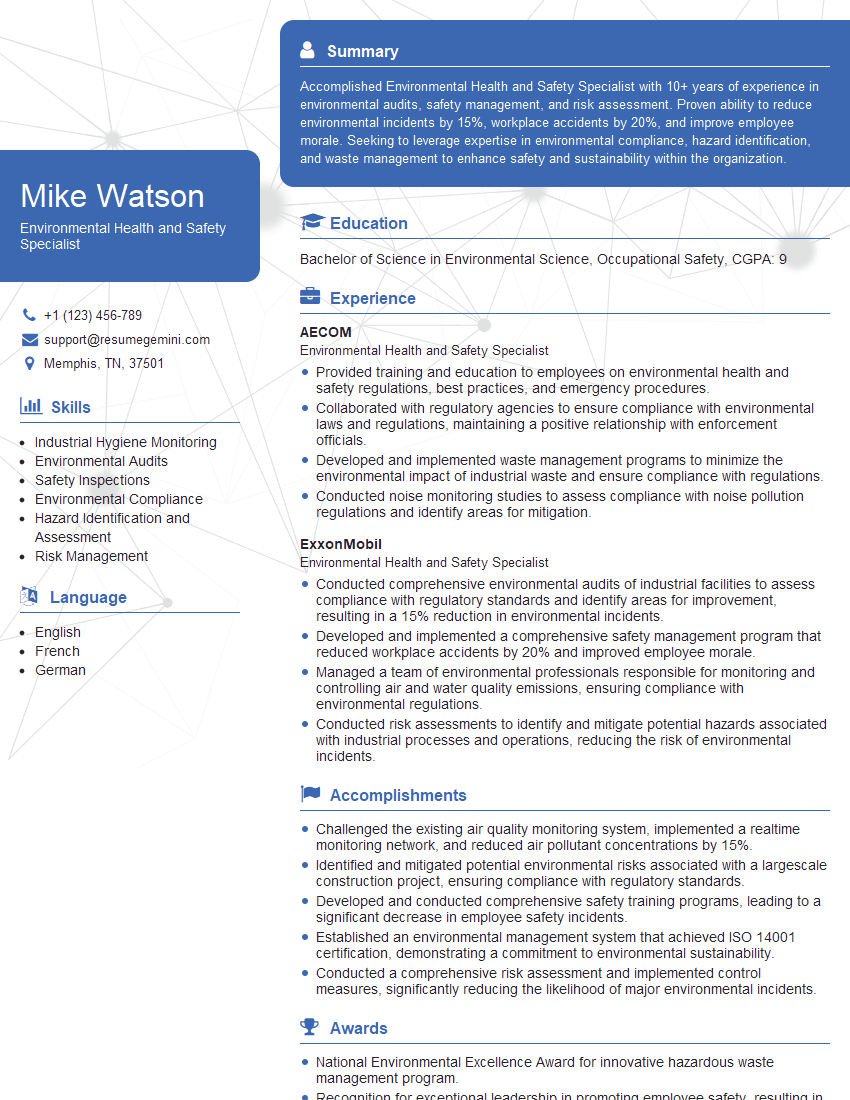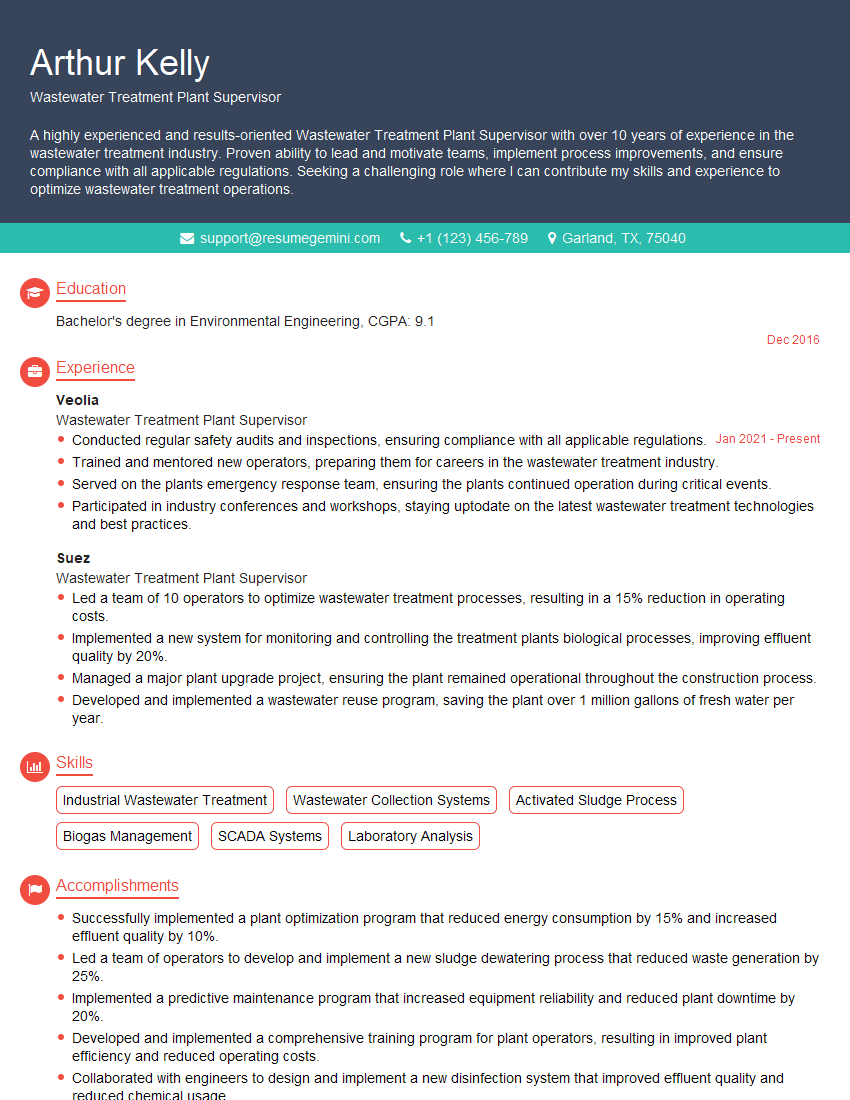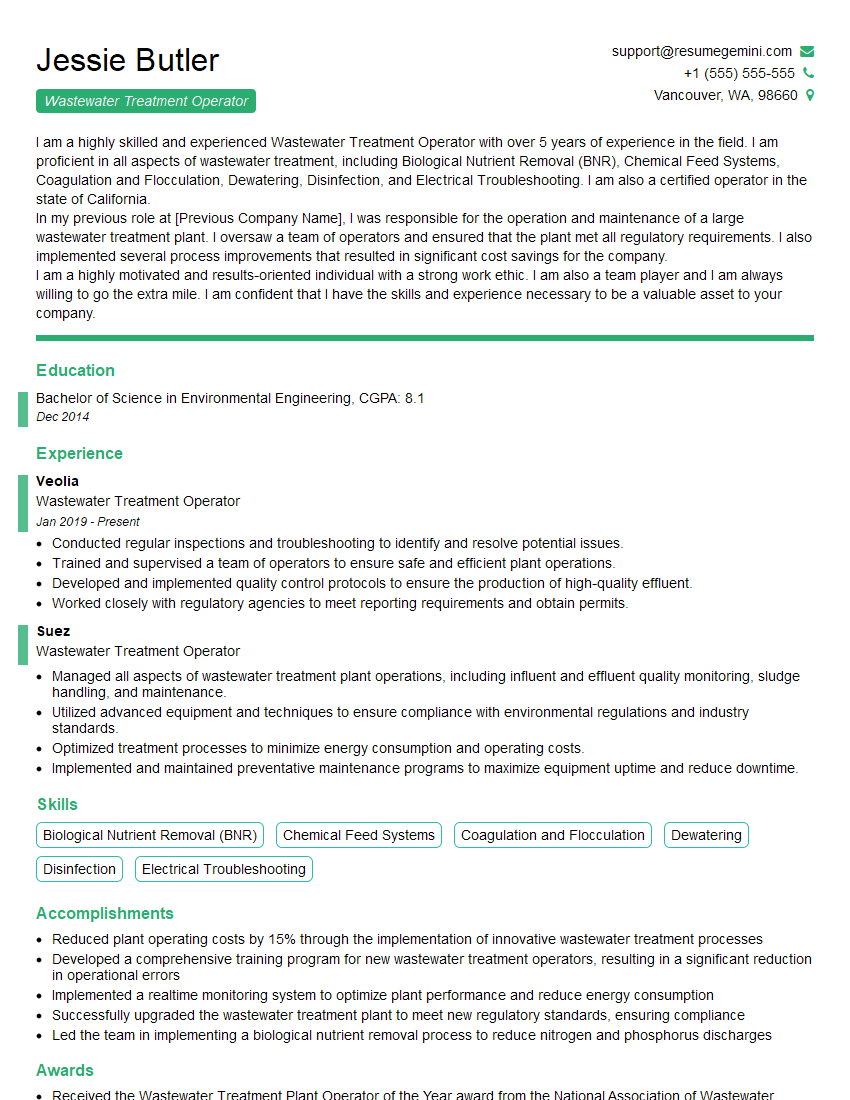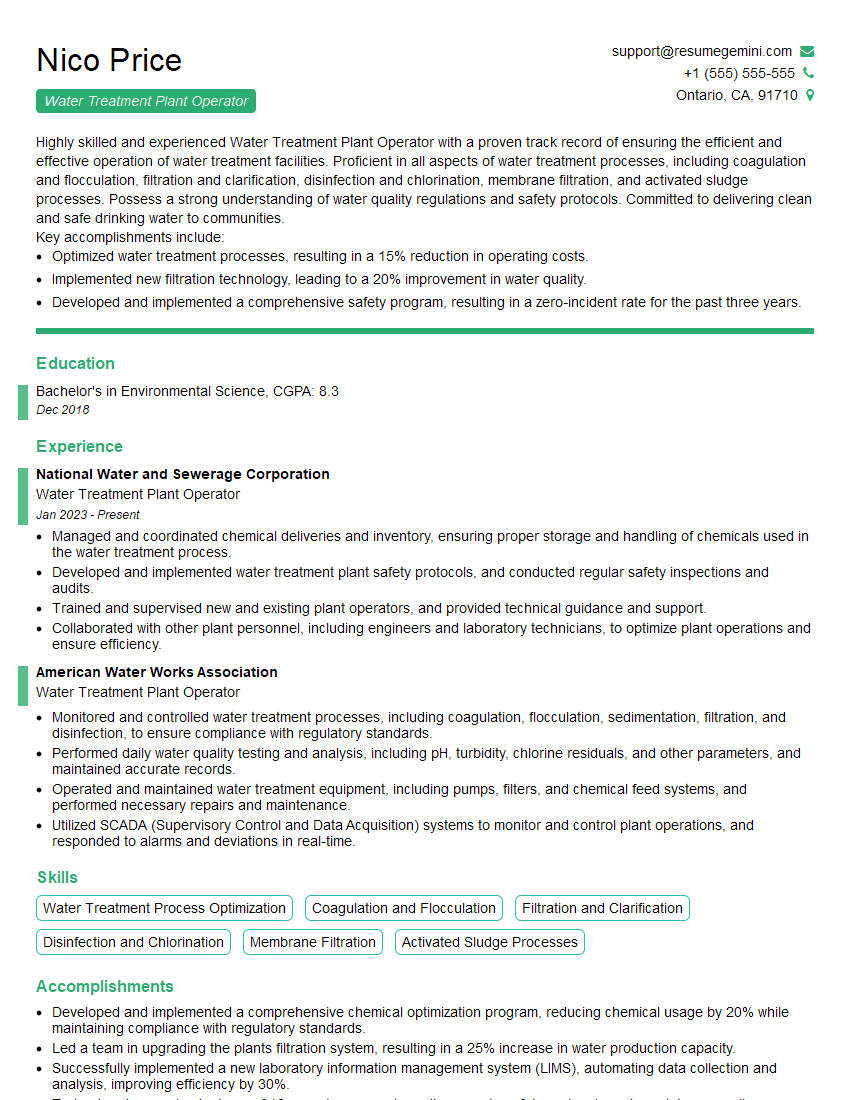Cracking a skill-specific interview, like one for BOD/COD Analysis, requires understanding the nuances of the role. In this blog, we present the questions you’re most likely to encounter, along with insights into how to answer them effectively. Let’s ensure you’re ready to make a strong impression.
Questions Asked in BOD/COD Analysis Interview
Q 1. Explain the difference between BOD and COD.
Both BOD (Biochemical Oxygen Demand) and COD (Chemical Oxygen Demand) are used to measure the amount of oxygen required to decompose organic matter in water. However, they differ significantly in their approach. BOD measures the oxygen consumed by biological processes, specifically by aerobic microorganisms breaking down organic matter over a specific time period (usually 5 days, hence BOD5). COD, on the other hand, measures the oxygen consumed by chemical oxidation of organic matter using a strong oxidizing agent, typically potassium dichromate. Think of it like this: BOD is a measure of how much oxygen microorganisms *need* to break down waste, whereas COD is a measure of how much oxygen is *theoretically available* for that breakdown through chemical means.
In essence, BOD reflects the *biodegradable* organic matter, while COD reflects the total amount of organic matter, both biodegradable and non-biodegradable.
Q 2. What are the limitations of BOD and COD tests?
Both BOD and COD tests have limitations:
- BOD: It’s time-consuming (typically 5 days), susceptible to interference from toxic substances that inhibit microbial activity, and only measures the readily biodegradable organic matter. It doesn’t account for slowly decomposing substances or those that are not biodegradable by microorganisms. For example, some plastics won’t be reflected in a BOD test.
- COD: While faster than BOD, it’s more expensive and may overestimate the amount of oxygen required as it oxidizes some inorganic substances like ammonia. It also doesn’t differentiate between biodegradable and non-biodegradable organic matter. Certain compounds may not be fully oxidized by the dichromate method.
Choosing between BOD and COD often depends on the specific application and the information needed. If you need a quick assessment of total organic pollution, COD is preferred. If the interest lies in the biodegradable portion, BOD is the better choice, despite its limitations.
Q 3. Describe the procedure for BOD analysis using the dilution method.
The dilution method for BOD analysis involves diluting a sample of wastewater with oxygen-saturated dilution water to create a series of bottles with varying sample concentrations. This ensures that the oxygen depletion during the incubation period remains within a measurable range (typically 2 mg/L to 7 mg/L). Here’s the procedure:
- Sample Collection and Preparation: Collect a representative sample and keep it cool and dark to minimize biological activity before analysis.
- Dilution Water Preparation: Prepare oxygen-saturated dilution water, often using phosphate buffer to maintain a stable pH.
- Dilution Series: Prepare a series of BOD bottles with varying dilutions of the wastewater sample. Each bottle should have sufficient dissolved oxygen to last through the test.
- Incubation: Incubate the bottles in the dark at a specific temperature (usually 20°C) for 5 days.
- Dissolved Oxygen Measurement: Measure the dissolved oxygen (DO) in each bottle before and after incubation using a DO meter or Winkler titration.
- BOD Calculation: Calculate the BOD5 using the formula: BOD5 = (DOinitial – DOfinal) * Dilution Factor.
Example: If the initial DO was 8 mg/L, the final DO was 4 mg/L, and the dilution factor was 1:10, the BOD5 would be (8-4) * 10 = 40 mg/L.
Q 4. How do you calculate BOD5 from BOD data?
BOD5 is simply the BOD value measured after 5 days of incubation. The BOD data you collect from the dilution method provides the BOD at 5 days. There’s no further calculation needed to get BOD5 if your test ran for 5 days. If you have BOD values at different time points (e.g., BOD1, BOD2, BOD3, etc.), you can use these to plot a BOD curve and extrapolate to find the BOD at 5 days if needed, but the direct measurement of BOD at the 5 day mark is what is usually reported as BOD5.
Q 5. Explain the principle of COD analysis using the dichromate method.
The dichromate method for COD analysis relies on the strong oxidizing power of potassium dichromate (K2Cr2O7) in an acidic medium. The sample is refluxed with a known excess of potassium dichromate and sulfuric acid. Organic matter in the sample is oxidized by the dichromate, reducing it to chromium(III) ions (Cr3+). The amount of dichromate remaining after the oxidation is determined by titration with a ferrous ammonium sulfate (FAS) solution. The difference between the initial and final dichromate concentration represents the amount of dichromate consumed by the oxidation of organic matter, which is directly proportional to the COD.
In simpler terms, we’re using a powerful chemical to burn all the organic matter in the sample. By measuring how much of the chemical was used, we can determine the amount of organic matter present.
Q 6. What are the common interferents in BOD and COD analysis?
Several substances can interfere with both BOD and COD analyses:
- BOD: Toxic compounds (heavy metals, chlorine), volatile organic compounds (affecting DO measurements), and the presence of certain microorganisms that may not be accurately representative of typical wastewater.
- COD: Chloride ions (Cl–) can interfere significantly by reacting with the dichromate, leading to an overestimation of COD. Other inorganic reducing agents can also produce falsely high COD values. Certain organic compounds might not be fully oxidized during the analysis, leading to underestimation.
Proper sample preparation and, in some cases, specialized techniques are necessary to minimize the impact of these interferents. For instance, mercuric sulfate is added to the COD reagent to minimize chloride interference.
Q 7. How do you prepare samples for BOD and COD analysis?
Sample preparation is crucial for accurate BOD and COD results:
- BOD: Samples should be collected in clean, dark bottles to minimize oxygen consumption before analysis. If necessary, the sample is filtered to remove suspended solids which may settle and affect oxygen availability in the BOD bottle. The pH needs to be optimal for microbial activity. In some cases, a specific dilution needs to be calculated to prevent excessive oxygen consumption.
- COD: Samples may be filtered to remove suspended solids, particularly for solids that can interfere with the oxidation process. The accurate measurement of the sample volume is paramount for accurate calculations. Certain chemical treatments such as adding mercuric sulfate to minimize chloride interferences are sometimes needed.
Proper handling and preservation of samples are essential to prevent changes in the organic matter content before analysis. For instance, refrigerating a sample is common, but this can affect some parameters, so the decision should be made based on the specific application.
Q 8. What are the units for BOD and COD?
Both BOD (Biochemical Oxygen Demand) and COD (Chemical Oxygen Demand) are expressed in milligrams per liter (mg/L) or parts per million (ppm). These units represent the mass of oxygen consumed per unit volume of water. Think of it like this: if you have a high BOD or COD, it means there’s a lot of ‘stuff’ in the water that needs oxygen to break down.
Q 9. What is the significance of BOD and COD in wastewater treatment?
BOD and COD are crucial indicators of water quality, particularly in wastewater treatment. They quantify the amount of organic matter present. BOD specifically measures the oxygen consumed by aerobic microorganisms while breaking down organic matter. A high BOD suggests a lot of biodegradable organic pollutants. COD, on the other hand, measures the oxygen required to chemically oxidize all organic and some inorganic substances in the water. It gives a total measure of oxidizable material, including both biodegradable and non-biodegradable components. In wastewater treatment, monitoring BOD and COD helps assess the efficiency of treatment processes, ensuring that the treated effluent meets discharge standards. For example, a high BOD in the effluent indicates the treatment plant isn’t effectively removing organic matter.
Q 10. How do you interpret BOD and COD results?
Interpreting BOD and COD results involves comparing them to regulatory limits and understanding the relationship between them. A high BOD indicates a significant amount of readily biodegradable organic matter, suggesting potential oxygen depletion in receiving waters and potentially harmful impacts on aquatic life. A high COD, even if the BOD is lower, suggests the presence of substances that are difficult to biodegrade, implying the need for more robust treatment methods. The BOD/COD ratio is particularly insightful; a low ratio (e.g., <0.5) may suggest the presence of recalcitrant organic matter that is resistant to biological degradation. A high ratio (closer to 1) suggests readily biodegradable organic matter, implying that biological treatment is efficient. For example, a wastewater sample with a BOD of 200 mg/L and a COD of 300 mg/L has a BOD/COD ratio of 0.67, suggesting a relatively high proportion of biodegradable organic matter.
Q 11. What are the regulatory limits for BOD and COD in wastewater discharge?
Regulatory limits for BOD and COD in wastewater discharge vary significantly depending on the country, region, and the receiving water body’s sensitivity. These limits are designed to protect aquatic life and human health. For instance, in many developed countries, the permitted BOD concentration might be as low as 10-20 mg/L, while the COD limit could range from 50-100 mg/L. Exceeding these limits can lead to penalties and legal action. These limits often differentiate between industrial and municipal discharges, with stricter regulations usually applied to industrial wastewater due to potential presence of more toxic compounds.
Q 12. Describe the role of microorganisms in BOD analysis.
Microorganisms, primarily aerobic bacteria, play a vital role in BOD analysis. The BOD test essentially measures the oxygen consumed by these microbes as they break down organic matter in the water sample. These organisms use oxygen during their metabolic processes to oxidize the organic compounds, and the amount of oxygen consumed is directly proportional to the amount of biodegradable organic matter present. Different microbial communities might exhibit varying efficiencies in degrading different types of organic molecules; thus, the microbial composition of the water sample itself could influence the BOD results.
Q 13. Explain the importance of seed microorganisms in BOD analysis.
Seed microorganisms are added to the BOD sample to ensure a sufficient and active microbial population capable of effectively degrading the organic matter within the incubation period. Without seed, a sample with low microbial diversity or biomass might exhibit a low or even inaccurate BOD reading due to insufficient microbial activity. The seed usually consists of a sample of wastewater from a treatment plant known to have a healthy, diverse microbial community. This ensures that the sample has enough active bacteria to start the decomposition process and gives consistent and reliable BOD results.
Q 14. What are the different types of COD digestion methods?
Several COD digestion methods exist, differing primarily in the oxidizing agent used. The most common methods include:
- Potassium Dichromate (K2Cr2O7) Method: This is a standard method using a strong oxidizing agent, potassium dichromate, in an acidic solution with a silver sulfate catalyst. This method is effective in oxidizing most organic compounds, including some recalcitrant ones.
- Potassium Permanganate (KMnO4) Method: This method uses potassium permanganate as the oxidizing agent and is less aggressive than the dichromate method. It’s often used for samples with lower organic matter concentrations or for situations where the dichromate method might not be suitable.
The choice of method depends on the nature of the sample and the desired level of accuracy. The dichromate method is more widely accepted for its effectiveness in oxidizing a broader range of organic compounds. However, permanganate is sometimes preferred for its relative simplicity and lower toxicity.
Q 15. Compare and contrast the BOD and COD methods.
Both BOD (Biochemical Oxygen Demand) and COD (Chemical Oxygen Demand) are crucial water quality parameters that measure the amount of oxygen required to break down organic matter in water. However, they differ significantly in their approach.
BOD measures the oxygen consumed by biological processes as microorganisms decompose organic matter aerobically. It’s a biological test that simulates natural decomposition processes over a specific incubation period (typically 5 days at 20°C). The result is expressed as mg/L of O2.
COD, on the other hand, measures the oxygen required for chemical oxidation of all organic and easily oxidizable inorganic matter. A strong oxidizing agent, typically potassium dichromate (K2Cr2O7) in an acidic solution, is used to oxidize the organic matter. This method is faster than BOD, typically taking a few hours, and includes more material in the measurement.
In essence, BOD reflects the biodegradable organic matter, while COD represents the total amount of oxidizable organic matter present. COD is always higher than BOD, as it includes substances that aren’t readily broken down biologically.
- Example: A wastewater sample might have a COD of 200 mg/L and a BOD of 100 mg/L. This indicates that 100 mg/L of oxygen is consumed by biological processes, while the remaining 100 mg/L is attributable to non-biodegradable or slowly biodegradable substances.
Career Expert Tips:
- Ace those interviews! Prepare effectively by reviewing the Top 50 Most Common Interview Questions on ResumeGemini.
- Navigate your job search with confidence! Explore a wide range of Career Tips on ResumeGemini. Learn about common challenges and recommendations to overcome them.
- Craft the perfect resume! Master the Art of Resume Writing with ResumeGemini’s guide. Showcase your unique qualifications and achievements effectively.
- Don’t miss out on holiday savings! Build your dream resume with ResumeGemini’s ATS optimized templates.
Q 16. Discuss the advantages and disadvantages of BOD and COD tests.
BOD Advantages:
- More relevant to natural processes: It reflects the actual oxygen demand exerted by microorganisms in a natural water body, giving a better indication of the impact on aquatic life.
- Sensitive to biodegradable organic matter: It specifically measures the oxygen demand from readily biodegradable organic pollutants, providing insight into the level of readily degradable pollution.
BOD Disadvantages:
- Time-consuming: Requires a 5-day incubation period, making it a slower test.
- Susceptible to interference: Results can be affected by factors such as toxicity, presence of inhibitors, and microbial population variations.
- Requires specialized equipment and trained personnel: Maintaining sterile conditions and accurate measurements requires expertise and specialized equipment.
COD Advantages:
- Rapid results: Typically completed within a few hours.
- Relatively easy to perform: Requires less technical expertise and simpler equipment.
- Measures total oxidizable organic matter: Provides a comprehensive measure of both biodegradable and non-biodegradable organic matter.
COD Disadvantages:
- Less ecologically relevant: Doesn’t reflect the actual biological oxygen demand in the environment.
- Less sensitive to biodegradable organic matter: May overestimate the oxygen demand if a large portion of the organic matter is not easily biodegradable.
- Uses hazardous chemicals: Requires handling of strong oxidizing agents like potassium dichromate, which pose safety risks.
Q 17. How can you improve the accuracy and precision of BOD and COD results?
Improving the accuracy and precision of BOD and COD results requires meticulous attention to detail at every stage of the analysis. Here’s how:
- Careful sample collection and preservation: Proper sampling techniques, avoiding contamination, and using appropriate preservatives to minimize biological activity or chemical changes before analysis are crucial. Ice-cold storage is often recommended.
- Accurate dilutions: Diluting samples to fall within the range of the instrument’s sensitivity is vital. Precise dilutions require accurate volumetric glassware and techniques.
- Calibration and maintenance of equipment: Regularly calibrate the equipment used (e.g., spectrophotometer for COD, BOD incubator) following manufacturer’s instructions to ensure accuracy and precision. Clean and maintain equipment properly.
- Reagent quality control: Use high-quality, certified reagents. Check their expiration dates and store them correctly.
- Use of blanks and standards: Running blanks (to account for reagent contamination) and standards (to check the accuracy of the measurements) in each batch is critical for validating the results.
- Replicate measurements: Conduct multiple tests on the same sample to improve the accuracy of the reported results and calculate the standard deviation.
- Appropriate method selection: The choice of a specific BOD or COD method will depend on the characteristics of the sample (e.g., toxicity) and the required level of detail. Knowing the limitations of different methods is crucial.
- Data analysis and quality assurance: Properly analyze the data, identify potential outliers, and use statistical methods to assess uncertainty. Following standard operating procedures (SOPs) and adhering to quality assurance/quality control (QA/QC) practices are essential.
Q 18. What are the safety precautions to be taken during BOD and COD analysis?
Safety is paramount during BOD and COD analysis, particularly when handling hazardous chemicals. Here are some crucial precautions:
- Personal Protective Equipment (PPE): Always wear appropriate PPE, including lab coats, safety goggles, gloves (nitrile gloves are recommended for COD due to its corrosive nature), and closed-toe shoes.
- Proper handling of chemicals: Handle chemicals carefully, following safety data sheets (SDS) and using appropriate equipment (e.g., fume hood for COD digestion). Avoid direct contact with skin and eyes.
- Waste disposal: Dispose of chemical waste according to local regulations and guidelines. Many COD reagents are hazardous and require specific disposal methods.
- Proper ventilation: Ensure adequate ventilation in the laboratory, especially during COD digestion, to minimize exposure to harmful fumes.
- Emergency preparedness: Be aware of the location and proper use of safety equipment such as eyewash stations, safety showers, and fire extinguishers.
- Training and awareness: All personnel should receive proper training on safe laboratory practices, handling hazardous materials, and emergency procedures before performing BOD and COD analyses.
Q 19. How do you troubleshoot common problems encountered during BOD and COD analysis?
Troubleshooting BOD/COD analysis involves systematically identifying and resolving potential issues. Here are some common problems and solutions:
- Low BOD results: This could indicate insufficient nutrient supply, microbial inhibition (from toxins), or improper incubation temperature. Check for these and adjust accordingly.
- High BOD/COD results: This can be due to sample contamination, errors in dilution, or improper handling of reagents. Repeat the analysis meticulously and verify reagent quality and dilutions.
- Inconsistent results: Poor mixing of the sample, inconsistent incubation conditions, or faulty equipment could lead to inconsistent data. Ensure that calibration is accurate, and incubation parameters are correctly maintained.
- Turbid samples: If samples are too turbid for spectrophotometric measurements in COD, proper filtration or dilution is necessary before analysis.
- Negative values: This is unlikely and points to procedural errors, such as a miscalculation of the reagent blank.
Systematic Approach: When encountering problems, begin by reviewing the entire procedure to pinpoint possible error sources, from sampling to data analysis. Refer to laboratory SOPs, consult experienced personnel, and keep detailed records of the troubleshooting steps taken.
Q 20. What quality control measures are important for ensuring reliable BOD and COD data?
Reliable BOD and COD data depend on robust quality control (QC) measures. These include:
- Use of certified reference materials (CRMs): Analyze CRMs with known BOD and COD values alongside samples to verify accuracy and precision.
- Regular calibration and maintenance of equipment: Calibration should be performed according to manufacturer’s guidelines using standards traceable to national or international standards.
- Blank samples: Regularly include blank samples (without the sample) in each batch to correct for reagent contamination or background interference.
- Duplicate samples: Run duplicate samples for each sample to assess the precision and reproducibility of the method. Calculate standard deviation and relative standard deviation.
- Control charts: Track the results over time using control charts to monitor the performance of the method and detect potential drift or systematic errors.
- Proficiency testing: Participate in proficiency testing programs to compare your results with other laboratories and evaluate your overall performance.
- Documentation and record keeping: Maintain detailed records of all aspects of the analysis, including sample information, procedure details, results, and QC data.
Q 21. Explain the concept of ultimate BOD.
Ultimate BOD refers to the total amount of oxygen that would be consumed by microorganisms if they were allowed to completely decompose all the biodegradable organic matter in a water sample. This is a theoretical value, as it’s impossible to wait for complete decomposition in practice.
The 5-day BOD (BOD5) value we typically measure is just a portion of the ultimate BOD. The ultimate BOD is usually estimated using a mathematical model, commonly a first-order kinetics equation, that uses several BOD values measured over time. This model extrapolates the measured values to determine the asymptotic limit, representing the ultimate BOD.
Understanding the ultimate BOD is important as it helps to gain a more comprehensive understanding of the total organic loading of a wastewater. This information is important for optimizing wastewater treatment design and management strategies. The ultimate BOD gives a better measure of the overall polluting potential of the wastewater.
Q 22. How do temperature and pH affect BOD and COD results?
Both BOD (Biochemical Oxygen Demand) and COD (Chemical Oxygen Demand) are significantly influenced by temperature and pH. Think of it like this: temperature affects how quickly microorganisms (for BOD) or chemical reactions (for COD) occur, while pH affects the efficiency of these processes.
Temperature: Higher temperatures generally accelerate both BOD and COD reactions. Microbes in BOD tests are more active at optimal temperatures (usually around 20°C), leading to higher BOD values within a shorter incubation period. Similarly, COD reactions, which involve strong oxidizing agents, proceed faster at elevated temperatures, resulting in higher COD readings. Conversely, lower temperatures slow both processes down.
pH: The optimal pH range for BOD analysis is typically neutral (around 6.5-7.5). Deviations from this range can inhibit microbial activity and thus lead to lower BOD values. For COD, while the exact optimal pH depends on the specific oxidant used (like potassium dichromate), extreme pH values (very acidic or alkaline) can interfere with the oxidation reaction and produce inaccurate results. For example, very high pH might precipitate certain substances, hindering oxidation.
Practical Example: A wastewater sample analyzed at 15°C will likely show a lower BOD than the same sample tested at 25°C. Similarly, a sample with a very acidic pH (say, 3) might yield a lower BOD and possibly a less accurate COD than a sample with a near-neutral pH.
Q 23. What are some alternative methods for measuring organic matter in water?
While BOD and COD are the most common methods, several alternatives exist for measuring organic matter in water. These methods offer different advantages depending on the specific application and the nature of the organic matter.
- Total Organic Carbon (TOC): TOC measures the total amount of carbon in organic compounds. It’s a faster and simpler method than BOD or COD, but it doesn’t differentiate between biodegradable and non-biodegradable organic matter.
- UV-Vis Spectroscopy: This technique uses the absorbance of ultraviolet and visible light to quantify organic matter. It’s relatively quick and easy but can be less specific than other methods.
- High-Performance Liquid Chromatography (HPLC): HPLC allows for the separation and quantification of individual organic compounds, providing a detailed composition of the organic matter present. It is very precise, but also significantly more complex and expensive.
- Gas Chromatography-Mass Spectrometry (GC-MS): GC-MS provides even higher resolution, identifying and quantifying many specific organic compounds. It’s very powerful, but is complex and costly.
The choice of method often depends on the desired level of detail and the available resources. For a quick assessment of organic loading, TOC might be sufficient. However, for a comprehensive understanding of the wastewater composition, including specific pollutants, techniques like HPLC or GC-MS might be necessary.
Q 24. Discuss the role of BOD and COD in assessing the effectiveness of wastewater treatment processes.
BOD and COD are crucial parameters in evaluating the effectiveness of wastewater treatment processes. They provide insights into the amount of organic matter removed during treatment.
BOD Removal Efficiency: By comparing the BOD of the influent (incoming wastewater) to the effluent (treated wastewater), we calculate the BOD removal efficiency. A high removal efficiency signifies a well-functioning treatment plant effectively reducing the biodegradable organic matter. For example, a reduction from 200 mg/L to 20 mg/L indicates a 90% BOD removal efficiency – a very good result.
COD Removal Efficiency: Similarly, COD removal efficiency assesses the overall removal of organic matter, both biodegradable and non-biodegradable. COD often provides a more comprehensive picture of organic matter, including refractory substances that are resistant to biological degradation. High COD removal indicates the effectiveness of processes like oxidation or advanced treatment technologies.
Monitoring Treatment Stages: BOD and COD analysis is not just for final effluent assessment; it’s also critical for monitoring each stage of the treatment process (e.g., primary settling, activated sludge, disinfection). Identifying bottlenecks or inefficiencies in specific treatment stages becomes possible through this process monitoring.
Compliance and Regulation: Wastewater treatment plants must meet specific discharge limits for BOD and COD set by regulatory agencies. Regular BOD and COD testing ensures compliance and prevents environmental pollution.
Q 25. How does the presence of toxic substances affect BOD and COD results?
Toxic substances can significantly impact BOD and COD results, often leading to inaccurate or misleading interpretations.
Inhibition of Microbial Activity (BOD): Certain toxicants (heavy metals, some pesticides, certain industrial chemicals) can inhibit or even kill the microorganisms responsible for BOD decomposition. This results in artificially low BOD values, masking the true extent of organic pollution. The presence of toxicity is often indicated by a slow or incomplete BOD degradation within the standard incubation period.
Interference with Oxidation Reactions (COD): Some toxic substances can interfere with the chemical oxidation reactions used in COD determination. They might act as reducing agents themselves, consuming oxidant and causing inflated COD readings, or they may bind the oxidant making it unavailable for oxidation of organic matter. They might also lead to errors in spectrophotometric analysis used to measure the remaining oxidant.
Toxicity Tests: Before performing BOD and COD analysis, it’s crucial to conduct toxicity tests to determine the potential interference of toxic substances. If toxicity is detected, appropriate pretreatment (such as dilution or detoxification) may be required to obtain reliable results. Failing to account for toxicity can lead to inaccurate environmental assessments and ineffective treatment strategies.
Q 26. What is the relationship between BOD, COD, and TOC?
BOD, COD, and TOC are all measures of organic matter in water, but they reflect different aspects of organic content.
- BOD (Biochemical Oxygen Demand): Measures the amount of oxygen consumed by aerobic microorganisms during the decomposition of biodegradable organic matter.
- COD (Chemical Oxygen Demand): Measures the amount of oxygen required to chemically oxidize all organic matter (biodegradable and non-biodegradable) using a strong oxidizing agent.
- TOC (Total Organic Carbon): Measures the total amount of carbon in organic compounds.
The relationship can be expressed as: BOD ≤ COD ≤ TOC. BOD is always less than or equal to COD because COD includes both biodegradable and non-biodegradable organic matter. COD is generally less than or equal to TOC, although under certain conditions, the chemical oxidation process might not fully oxidize all the carbon in complex organic structures.
Example: In a wastewater sample, you might find a BOD of 100 mg/L, a COD of 150 mg/L, and a TOC of 180 mg/L. This indicates that 100 mg/L of oxygen was consumed by microbes, 150 mg/L was needed for complete chemical oxidation of all organic matter, and 180 mg/L represents the total organic carbon content.
Q 27. How can you use BOD and COD data to design a wastewater treatment plant?
BOD and COD data are essential for designing effective wastewater treatment plants. They dictate the size, configuration, and operational parameters of various treatment units.
Sizing Treatment Units: The influent BOD and COD values determine the required treatment capacity. Higher BOD and COD values indicate a greater organic load and hence a larger treatment plant is needed. For example, a high BOD necessitates a larger aeration tank in an activated sludge system to accommodate the higher microbial activity for efficient biodegradation.
Selecting Treatment Processes: The ratio of BOD to COD can provide insights into the nature of organic matter. A high BOD/COD ratio suggests a greater proportion of biodegradable organic matter, suggesting that biological treatment is appropriate. A low BOD/COD ratio implies a significant proportion of refractory organic matter, which necessitates additional treatment processes like advanced oxidation processes.
Monitoring Performance: During the operational phase, regular BOD and COD analysis helps in optimizing the treatment process. Any deviation from the design parameters, for example, a significant increase in effluent BOD and COD, can point to process upsets or equipment failure, requiring immediate attention.
Example: If a preliminary assessment reveals consistently high COD values and low BOD/COD ratios, the design may include a combination of biological treatment followed by advanced oxidation processes like ozonation or UV disinfection to achieve the desired effluent quality.
Q 28. Describe the different types of equipment used in BOD and COD analysis.
BOD and COD analyses utilize specific equipment tailored to their unique methodologies.
- BOD Analysis:
- BOD Bottles: Special glass bottles with airtight stoppers are used to prevent oxygen diffusion during incubation.
- Incubator: A temperature-controlled incubator maintains a constant temperature (usually 20°C) for the BOD test.
- Dissolved Oxygen (DO) Meter: A DO meter is used to measure the initial and final DO concentrations in the BOD bottles. It is crucial for precise DO measurement.
- COD Analysis:
- Reflux apparatus: A reflux apparatus, including a flask and condenser, is used to prevent loss of volatile compounds during the digestion process.
- Heating Mantle or Hot Plate: Provides controlled heating for the digestion process. The temperature is critical for complete oxidation.
- Spectrophotometer: Used to measure the absorbance of the solution after digestion, allowing for quantification of the remaining oxidant and thus the COD.
- Titrator (for some COD methods): In some COD methods, a titrator might be used to determine the amount of remaining oxidant instead of spectrophotometry.
Proper calibration and maintenance of all equipment are crucial for accurate and reliable results in both BOD and COD analysis. Following established standard operating procedures (SOPs) ensures consistent and reliable data quality.
Key Topics to Learn for BOD/COD Analysis Interview
- Biochemical Oxygen Demand (BOD): Understanding the principles behind BOD, its significance in assessing water quality, and the methodologies used for its determination (e.g., dilution method, respirometric methods). Consider the limitations and potential sources of error.
- Chemical Oxygen Demand (COD): Grasping the concept of COD, its relationship to BOD, and the different oxidation methods employed (e.g., dichromate reflux method). Analyze the advantages and disadvantages of COD testing compared to BOD testing.
- BOD/COD Ratio: Interpreting the BOD/COD ratio and its implications for wastewater treatment processes and overall water quality. Understand how this ratio helps in determining the biodegradability of organic matter.
- Sample Collection and Preservation: Mastering the techniques for proper sample collection, storage, and preservation to ensure accurate and reliable BOD/COD results. This includes understanding the impact of storage conditions on the results.
- Data Analysis and Interpretation: Developing proficiency in analyzing BOD/COD data, interpreting results, and drawing meaningful conclusions relevant to environmental monitoring and wastewater treatment optimization. Practice working with different data sets and identifying potential outliers.
- Wastewater Treatment Processes: Understanding how BOD and COD measurements are used to monitor the effectiveness of different wastewater treatment processes (e.g., activated sludge, trickling filter). Be prepared to discuss the impact of various treatment stages on BOD and COD reduction.
- Regulatory Compliance: Familiarize yourself with relevant environmental regulations and standards related to BOD/COD limits and reporting requirements. Understand the implications of non-compliance.
Next Steps
Mastering BOD/COD analysis is crucial for a successful career in environmental science, engineering, and related fields. A strong understanding of these concepts demonstrates a commitment to environmental protection and opens doors to diverse opportunities. To maximize your job prospects, focus on creating a professional, ATS-friendly resume that effectively highlights your skills and experience. ResumeGemini is a trusted resource to help you build a compelling resume tailored to the specific demands of your target roles. Examples of resumes specifically crafted for BOD/COD Analysis professionals are available, providing valuable templates and guidance.
Explore more articles
Users Rating of Our Blogs
Share Your Experience
We value your feedback! Please rate our content and share your thoughts (optional).
What Readers Say About Our Blog
Take a look at this stunning 2-bedroom apartment perfectly situated NYC’s coveted Hudson Yards!
https://bit.ly/Lovely2BedsApartmentHudsonYards
Live Rent Free!
https://bit.ly/LiveRentFREE
Interesting Article, I liked the depth of knowledge you’ve shared.
Helpful, thanks for sharing.
Hi, I represent a social media marketing agency and liked your blog
Hi, I represent an SEO company that specialises in getting you AI citations and higher rankings on Google. I’d like to offer you a 100% free SEO audit for your website. Would you be interested?
